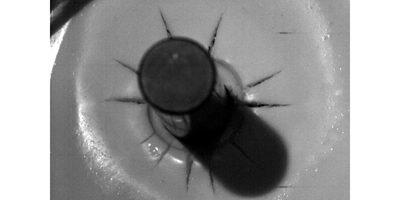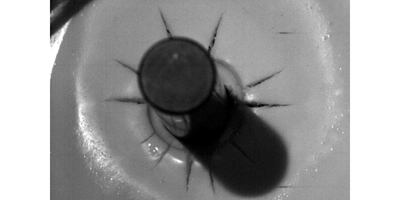Cracks in the Cornstarch
Collections of particles, whether dry or suspended in liquid, can act like either fluids or solids under different conditions. A household example is a mixture of cornstarch and water, which normally flows slowly like a viscous liquid but when rapidly shocked can be solid enough to hold a person’s weight (for a second or two). In Physical Review Letters, Matthieu Roché and colleagues at Princeton University, New Jersey, characterize how this stiff material then cracks, if the stress is high enough.
On impact, the stiffening of a rapidly deformed suspension reflects “jamming”: the liquid is expelled, but the cornstarch particles (typically microns in size) are pushed against each other before they can get out of the way, so they form a rigid framework. The team used high-speed photography to monitor a thin layer of the suspension as they dropped a cylindrical rod end-on onto the layer from various heights. The impact creates a solid ring a few millimeters thick—visible because it is less glossy than the initial suspension—and then a gap opens around the cylinder. If the layer is thin enough, though, cracks rapidly shoot out radially from the edge of this hole, propagating further in thinner layers. The cracks then heal as water flows back into the solidified region. Roché et al.’s careful measurements under various conditions let the researchers calculate the mechanical strength of the short-lived solid, as well as the kinetic energy required to cause crack propagation. The counterintuitive behavior could shed light on other important liquid-particle mixtures ranging from foodstuffs to earthquake-jostled ground. – Don Monroe





